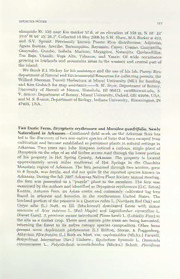
Two Exotic Ferns, Dryopteris Erythrosora and Marsilea Quadrifolia, Newly Naturalized in Arkansas PDF
Preview Two Exotic Ferns, Dryopteris Erythrosora and Marsilea Quadrifolia, Newly Naturalized in Arkansas
m SHORTER NOTES Km alongside Rt. 155 near marker an N 57.6, at elevation of 158 m, 18 22' W 39.6" 66° May 25' 26.2". Collected 19 2006 by S.W. Shaw, M.S. Barker #453, and known S.V. Sprunt. Previously Puerto Rico distribution: Adjuntas,' Aguas Buenas, Arecibo, Barranquitas, Bayamon, Cayey, Coamo, Guayanilla, Guaynabo, Gurabo, Isabela, Maricao, Mayagiiez, Naranjito, Quebradillas, Toa Baja, Utuado, Vega Alta, Yabucoa, and Yauco. Of wide occurrence growing in lowlands and mountains areas in the western and central part of the island. We thank Hickey and R.J. for his assistance the use of his Puerto Rico lab, department and of Natural Environmental Resources for collecting permits, the Willard Sherman Herbarium Miami Turrell (MU) University at funding, for and Ken Grabach map W. for assistance. Shaw, Department S. of Botany! University Hawaii Manoa, of Honolulu, HI at 96822, [email protected], S. V. Sprunt, Department Miami OH of Botany, University, Oxford, USA, 45056, and M. Barker, Department S. of Biology, Indiana University, Bloomington, IN USA. 47405, Two Exotic Ferns, Dryopteris erythrosora and Marsilea Newly quadrifolia, Naturalized Arkansas.— in Continued field work on the Arkansas has flora led to the discovery of two non-native species of ferns that have escaped from and become cultivation established as persistent plants in natural settings in Two Arkansas. Simpson years John ago, noticed a curious, single plant of on Dryopteris the edge of an old timber access road through the lower portion of his property in Hot Spring County, Arkansas. The property located is approximately seven miles southwest Hot of Springs Ouachita in the Mountain The region of Arkansas. fern persisted through two winters, grew to 8 fronds, was fertile, and did not quite the reported species known fit in Arkansas. During the 2007 Arkansas Native Plant Society annual fall meeting, was the fern presented as a "puzzle" plant to the members. The fern was examined by the authors and identified as Dryopteris erythrosora (D.C. Eaton) Autumn Kuntze, an Asian and commonly Fern, exotic cultivated log fern found and in arboreta ferneries in the southeastern United The States. lowland portion of the preserve a Quercus rubra (Northern Red Oak) and is L. Carya alba Nutt. ex (Mockemut) dominated with minor (L.) Ell. forest amounts of Acer rubrum (Red Maple) and Liquidambar L. styraciflua L. A (Sweet Gum). owner previous introduced Pinus taeda L. (Loblolly Pine) to now the site as a timber crop. Those mature pine trees are being harvested, returning canopy the forest to native species composition. Other its ferns present were Asplenium platyneuron & (L.) Britton, Sterns, Poggenberg, Athyrium filix-femina Roth ex Mert. var. asplenioides (Michx.) (L.) Farwell, Botrychium biternatum Underw., Equisetum hyemale Osmunda (Sav.) L. cinnamomea Polystichum acrostichoides (Michx.) L., Schott, Pteridium VOLUME NUMBER AMERICAN FERN JOURNAL: 98 112 2 (2008) Kuhn pseudocaudatum and Woodwardia aquilinum var. (Clute) Heller, (L.) Moore. areolata (L.) Autumn The The Fern spore source not local to the preserve. closest is Woodland mi on potential source Garvan Gardens, located 10 to the east the is southeast of Hot Springs, Garland County, Arkansas. There the fern has A naturalized and spread from cultivation. secondary potential source 150 is Union miles distant in southern Arkansas on private property at Calion, The known. County, Arkansas. actual source not This report the is is first away instance in Arkansas where the fern has escaped well from any potential and and source plant by long distance dispersal of spores has established matured into a successful colonization that can replicate itself in the preserve The by local spore dispersal. lack of similar reports from other states, published or in web-based data bases also suggests that this might be the first such report the United The fern has not been eradicated from the for States. A ARKANSAS: Hot Spring Co.: single plant of eight fronds with four fertile, persisting for two years along an old timber access road (Weyerhaeuser 33150) near the Garland Co. line, at the base of a western peak on the north side of Trapp Mountain, within the Simpson Preserve, now owned and managed by R21W the Nature Conservancy as Trap Mountain Preserve; T4S Si 3. Vouchered 13 October 2007 by Witsell 07-578 (ANHC) and 30 October 2007 by Peck 07-2041 LRU; compared material from Garvan Woodland Gardens, to Crank 07-142 (LRU). Marsilea quadrifolia European Waterclover Fern, was discovered the L., for summer time in Arkansas during a preliminary survey of the shore and first km aquatic macrophytes flora found along the lower 6 of the Little Maumelle River, where empties into the Arkansas River, just west of the City of Little it Rock western Pulaski County, Arkansas. Along downstream in this reach, the broadens and slows, becoming almost and dominated with river slough-like, is Taxodium distichum Rich. (Bald Cypress) and Nyssa aquatica (Tupelo (L.) L. Gum). Here the river supports a particularly rich aquatic macrophyte flora many composed of native emergent, and submerged macrophytes floating-leaf, and exotic and invasive species, such as Hydrilla Royal verticillata (L.f.) (Water-thyme) and Eichhornia crassipes (Mart.) Solms (Water Hyacinth). The fern population appeared to be of one patch or spreading clone, suggestive or a recent introduction, probably by waterfowl. The population will be monitored. Previous reports of this species in Arkansas were misidentified Marsilea & Hook. Grev. Water-clover vestita (Prairie Fern). ARKANSAS: Growing Pulaski Co.: with floating-leaf and emergent macro- phytes vegetation on the north shore of the Maumelle 200 meters Little River, upstream of the Pinnacle Valley Road bridge spans T2N R13W that the river; Vouchered on 16 2007 by Peck 07-1514 (LRU).— and S7. July John Simpson Don Crank, Hot Springs, AR, Theo Arkansas C. Witsell, Natural Heritage Commission (ANHC), Rock, AR, and Little James H. Peck, University of - Rock Arkansas (LRU), Rock, AR. Little Little
